(Topic Claim) |
(Rough Draft) |
||
| (6 intermediate revisions by the same user not shown) | |||
| Line 1: | Line 1: | ||
| − | This | + | = Fourier Transforms = |
| + | === Author: Luke Oxley === | ||
| + | |||
| + | ===Table of Contents:=== | ||
| + | # Introduction | ||
| + | # Euler’s Formula | ||
| + | # Formula Visualization | ||
| + | # Example | ||
| + | # Inverse Transform | ||
| + | # Applications | ||
| + | # References and Further Reading | ||
| + | |||
| + | ===1. Introduction=== | ||
| + | The Fourier transform is a method used to break a function down into a representation of its frequencies. This method can be thought of as transforming from the time domain (a function with time as the input variable) to the frequency domain (a function with frequency as the input). This function in the frequency domain is a way of representing how much of each frequency is prevalent in the function. The Fourier transform allows for signals to be broken into their individual frequency components. The advantage of extracting the individual frequencies is that this allows for the individual manipulation of each frequency and for a unique representation of the function. Once you have extracted the component frequencies, many times it is possible to express the original function with sine and cosine waves at these frequencies. I like to picture this representation as a Taylor series, but instead of being based on derivatives, it is based on frequencies. This transform is useful in many fields, especially for analyzing electrical and sound signals. The purpose of this page is for you to gain an understanding of the basics of this transform, including a way to mentally visualize what this formula is doing and its applications. | ||
| + | <br /><br /> | ||
| + | One area of confusion is the difference between the Fourier series and the Fourier transform. The Fourier transform can be thought of as a limited case of the Fourier series. The series is mainly concerned with periodic functions while the transform is concerned with nonperiodic functions. | ||
| + | |||
| + | ===2. Euler's Formula=== | ||
| + | To understand the formula for the Fourier transform, it is helpful to have knowledge of Euler’s formula:<br /><br /> | ||
| + | <math> e^{it} = \cos t + i\sin t </math><br /><br /> | ||
| + | One way of representing a unit circle is parametrically with sines and cosines:<br /><br /> | ||
| + | <math>x = \cos t</math><br /> | ||
| + | <math>y = \sin t</math><br /><br /> | ||
| + | Euler’s formula allows for an elegant representation of a unit circle in the complex plane. Instead of using sines and cosines like in our parameterization, these can be substituted out with a simpler expression of <math>e^{it}</math>. Another nice thing about Euler’s formula is that since it represents a unit circle where t is the angle in radians, t also represents the arclength traveled around the circle. <br /> | ||
| + | [[File:ComplexPlaneCircle.png]]<br /> | ||
| + | Furthermore, the period of a full revolution around the circle in this formula is 2π radians. To convert this period into a desired frequency, we add a coefficient of 2πf to the exponent, where f is the desired number of rotations per second around the circle:<br /><br /> | ||
| + | <math>e^{2\pi ift} = \cos 2\pi ft + i\sin 2\pi ft</math><br /><br /><br /> | ||
| + | ===3. Formula Visualization=== | ||
| + | As previously stated, the Fourier transform converts a function from the time domain to the frequency domain. To do this, we need to have a way to extract the amount of each frequency contained in the function. Personally, when learning a new concept, I find it helpful, when possible, to visualize it. For example, I will break the Fourier transform formula into components and explain where they come from. First, we will start with Euler’s formula containing the frequency variable:<br /><br /> | ||
| + | <math>e^{-2\pi ift}</math><br /><br /> | ||
| + | Currently, we have a circle with a radius of one, determined by the coefficient of ''e'', and frequency ''f''. The negative in the exponent makes an increasing time ''t'' correlate to clockwise motion around the circle. Now, picture yourself taking a function and wrapping it around this circle at a certain frequency. For example, let <math>g(t) = \sin(3*2\pi t) + 1</math> (graph pictured below). To wrap ''g(t)'' around the circle, we must make the radius determined by ''g(t)''. Since the coefficient of ''e is'' the radius of the circle, we make ''g(t)'' the coefficient:<br /><br /> | ||
| + | <math>g(t)e^{-2\pi ift}</math><br /> | ||
| + | [[File:SineWave3Hz.png]]<br /> | ||
| + | If we wrap g around the circle at a frequency ''f'' = 1, we are basically snipping a section of the graph from t = 0 to t = 1 (between the red lines) and making one complete revolution:<br /> | ||
| + | [[File:SineWaveSingleWrap.png]]<br /> | ||
| + | Notice how there are three peaks on ''g(t)'', from t = 0 to t = 1, correlating to three petals on our wrapped version. Now, we will wrap the function around the circle with ''f'' = 2. We are taking the same snippet as before, but forming two complete revolutions with it around the circle:<br /> | ||
| + | [[File:SineWaveDoubleWrap.png]]<br /> | ||
| + | Again, we do this with ''f'' = 3, the same frequency of g. We wrap the snippet around the circle three times. As g makes three “hills” in one second, we will form three revolutions from t = 0 to t = 1. This results in each “hill” overlapping, forming one distinct shape:<br /> | ||
| + | [[File:SineWaveTrippleWrap.png]]<br /> | ||
| + | Notice how using a frequency that is highly prevalent in the function produces a unique result. One way to distinguish this result from the others is by looking at the shape’s center of mass. You will notice that the centers of mass for the first two shapes are very close to or at the origin. However, when the wrapping frequency matches that of the function, the center of mass is noticeably far from the origin. To model this mathematically, we take the center of mass of our current expression:<br /><br /> | ||
| + | <math>\frac{1}{t_{2}-t_{1}}\int_{t_{1}}^{t_{2}}g(t)e^{-2\pi ift}dt</math><br /><br /> | ||
| + | Currently, this function uses frequency f as the input variable and outputs a value that is proportional to the amount of that frequency in the function. For example, if we set f = 3, the output value will be quite high because g literally has a frequency of 3. Our current model is dividing out the length of the time interval. However, the actual Fourier transform eliminates this portion. Eliminating the division means that the longer a specific frequency is prevalent in the function, the larger the value returned. In addition, the Fourier transform usually eliminates the bounds and instead utilizes an improper integral:<br /><br /> | ||
| + | <math>\int_{-\infty}^{\infty}g(t)e^{-2\pi ift}dt</math><br /><br /> | ||
| + | Although equivalent, the common notation of the Fourier transform is denoted as transforming the function f(x) into f ̂(ξ) where ξ is the input frequency:<br /><br /> | ||
| + | <math>\hat{f}(\xi) = \int_{-\infty}^{\infty}f(x)e^{-2\pi i\xi x}dx</math><br /><br /> | ||
| + | Pictured above is the formula for the Fourier transform. Note that in this specific example I used a periodic function for ''g(t)''. Keep in mind that this transform can be applied to a non-periodic function as well. To reiterate, the Fourier transform converts from the time domain (a function ''g(t)'') to the frequency domain (a function of ξ). In many cases, it is easier to work with and modify a function once it is broken down into its component frequencies.<br /><br /> | ||
| + | ===4. Example=== | ||
| + | A classic example used to demonstrate the Fourier transform is with the simple rectangle function:<br /><br /> | ||
| + | <math>g(t)=\left\{\begin{matrix} | ||
| + | 1 & \left | t \right |\leq 0.5\\ | ||
| + | 0 & \left | t \right |> 0.5 | ||
| + | \end{matrix}\right.</math> | ||
| + | [[File:RectFunction.png]]<br /> | ||
| + | Since the function is 0 outside of -0.5 and 0.5, the value of the Fourier transform is also 0 outside the interval as well. This means we can simply integrate using bounds of -0.5 and 0.5:<br /><br /> | ||
| + | <math>\hat{f}(\xi) = \int_{-0.5}^{0.5}g(t)e^{-2\pi i\xi t}dt</math><br /><br /> | ||
| + | Now, we integrate this function, only considering the real component. Notice that we can replace g(t) with a one since its value is one on our entire bounds of integration, greatly simplifying this problem:<br /><br /> | ||
| + | <math>\int_{-0.5}^{0.5}g(t)e^{-2\pi i\xi t}dt = \int_{-0.5}^{0.5}1*\cos (-2\pi\xi t) dt = | ||
| + | \frac{\sin (\pi \xi)}{\pi\xi} = sinc(\xi)</math><br /><br /> | ||
| + | This resultant expression is also referred to as the “sink” function, as shown above, due to its popularity and recurrence in the subject of Fourier transforms. Below is a graph of the Fourier transform of g, the sinc function:<br /> | ||
| + | [[File:SincFunc.png]]<br /><br /> | ||
| + | ===5. Inverse=== | ||
| + | Currently we have a way of transforming a function from the time domain to the frequency domain. How do we return from the frequency domain to the time domain? To do this we use the inverse transform:<br /><br /> | ||
| + | <math>f(x) = \int_{-\infty}^{\infty}\hat{f}(\xi)e^{2\pi i\xi x}dx</math><br /><br /> | ||
| + | Notice that this is simply the same equation as the Fourier transform, but without the negative in the exponent. I like to think of it as if the Fourier transform is moving clockwise due to the negative. Then, to revert to the original function, simply go counterclockwise by removing the negative. <br /><br /> | ||
| + | ===6. Applications=== | ||
| + | Ok, so we have a way to transform a function between the time and frequency domains. Why would we ever want to do this? Sometimes a function is simpler expressed in the frequency domain. For example, when solving differential equations with boundary constraints it is sometimes quite difficult to solve in the time domain. Using the Fourier transform, one can convert to the frequency domain, solve the problem, then revert to the time domain. <br /><br /> | ||
| + | Other important applications are analyzing and modifying signals. If someone wants to adjust the signal based on its frequencies, they can use the Fourier transform. If someone desires to remove an annoying frequency from a soundwave, they can simply use the transform, remove the unwanted portion, then revert back. The Fourier transform makes dealing with specific frequencies quite simple. The use of the transform for signal analysis is highly prevalent in the fields of electrical and sound engineering.<br /><br /> | ||
| + | The transform is also used in the field of image processing. Many optical character recognition algorithms rely on the Fourier transform. It turns out that the Fourier transform of different characters, no matter the font, are quite distinct. In addition, the transform can detect unwanted periodic patterns in images and filter them out.<br /><br /> | ||
| + | Other applications of the Fourier transform are in quantum mechanics, especially with the Uncertainty Principle. <br /><br /> | ||
| + | ===7. References and Further Readings=== | ||
| + | In learning what the Fourier transform is, I thought that this intuitive explanation done by Blue1Brown helped a lot:<br /><br /> | ||
| + | [https://www.youtube.com/watch?v=spUNpyF58BY&ab_channel=3Blue1Brown%20 https://www.youtube.com/watch?v=spUNpyF58BY&ab_channel=3Blue1Brown] (Visual Model)<br /><br /> | ||
| + | Once I had an idea of what the transform is doing, these lecture notes provided a more formal analysis of the topic:<br /><br /> | ||
| + | [http://www.math.ncku.edu.tw/~rchen/2016%20Teaching/Chapter%202_Fourier%20Transform.pdf http://www.math.ncku.edu.tw/~rchen/2016%20Teaching/Chapter%202_Fourier%20Transform.pdf] (Transform Lecture Notes)<br /><br /> | ||
| + | And, of course, the Wikipedia article helps quite a bit:<br /><br /> | ||
| + | [https://en.wikipedia.org/wiki/Fourier_transform https://en.wikipedia.org/wiki/Fourier_transform ] (Wikipedia Page)<br /><br /> | ||
| + | If you still are having trouble understanding it, or would like to play around with a visual representation, I recommend the following two links. The first offers a depiction of how the Fourier transform can be used to write an equation out of sines. The next displays something similar but takes it to the next level with 2d drawings.<br /><br /> | ||
| + | [http://www.jezzamon.com/fourier/ http://www.jezzamon.com/fourier/ ] (Normal Model)<br /> | ||
| + | [https://betterexplained.com/articles/an-interactive-guide-to-the-fourier-transform/ https://betterexplained.com/articles/an-interactive-guide-to-the-fourier-transform/ ] (2D Drawing Model)<br /><br /> | ||
| + | Additional Sources:<br /><br /> | ||
| + | [https://en.wikipedia.org/wiki/Euler%27s_formula https://en.wikipedia.org/wiki/Euler%27s_formula ] (Euler's Formula Depiction)<br /> | ||
| + | [https://www.google.com/url?sa=t&rct=j&q=&esrc=s&source=web&cd=&cad=rja&uact=8&ved=2ahUKEwiKlpSXhbbtAhULCs0KHUFnDp8QFjABegQIBhAC&url=https%3A%2F%2Fwww.researchgate.net%2Fprofile%2FRebika_Rai%2Fpost%2FCan_any_one_suggest_me_good_article_on_2D_FFT%2Fattachment%2F59d64a1479197b80779a472d%2FAS%253A473872400162818%25401489991392897%2Fdownload%2F3.pdf&usg=AOvVaw2Qq8ofQ_NE3wmVqzKgFdfd Optical Character Recognition Document] | ||
| + | |||
| + | |||
| + | |||
| + | |||
| + | |||
| + | |||
| + | |||
| + | |||
| + | |||
| + | |||
| + | |||
| + | |||
| + | |||
| + | |||
| + | |||
| + | |||
| + | [[Category:MA271Fall2020Walther]] | ||
Latest revision as of 13:20, 5 December 2020
Contents
Fourier Transforms
Author: Luke Oxley
Table of Contents:
- Introduction
- Euler’s Formula
- Formula Visualization
- Example
- Inverse Transform
- Applications
- References and Further Reading
1. Introduction
The Fourier transform is a method used to break a function down into a representation of its frequencies. This method can be thought of as transforming from the time domain (a function with time as the input variable) to the frequency domain (a function with frequency as the input). This function in the frequency domain is a way of representing how much of each frequency is prevalent in the function. The Fourier transform allows for signals to be broken into their individual frequency components. The advantage of extracting the individual frequencies is that this allows for the individual manipulation of each frequency and for a unique representation of the function. Once you have extracted the component frequencies, many times it is possible to express the original function with sine and cosine waves at these frequencies. I like to picture this representation as a Taylor series, but instead of being based on derivatives, it is based on frequencies. This transform is useful in many fields, especially for analyzing electrical and sound signals. The purpose of this page is for you to gain an understanding of the basics of this transform, including a way to mentally visualize what this formula is doing and its applications.
One area of confusion is the difference between the Fourier series and the Fourier transform. The Fourier transform can be thought of as a limited case of the Fourier series. The series is mainly concerned with periodic functions while the transform is concerned with nonperiodic functions.
2. Euler's Formula
To understand the formula for the Fourier transform, it is helpful to have knowledge of Euler’s formula:
$ e^{it} = \cos t + i\sin t $
One way of representing a unit circle is parametrically with sines and cosines:
$ x = \cos t $
$ y = \sin t $
Euler’s formula allows for an elegant representation of a unit circle in the complex plane. Instead of using sines and cosines like in our parameterization, these can be substituted out with a simpler expression of $ e^{it} $. Another nice thing about Euler’s formula is that since it represents a unit circle where t is the angle in radians, t also represents the arclength traveled around the circle.
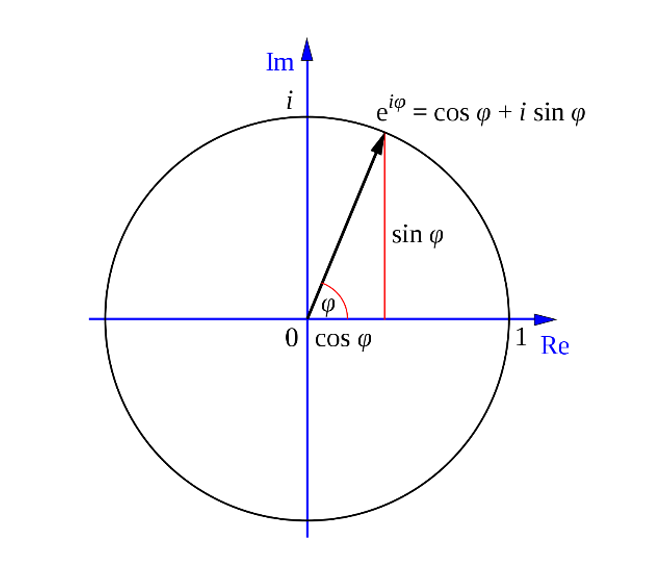
Furthermore, the period of a full revolution around the circle in this formula is 2π radians. To convert this period into a desired frequency, we add a coefficient of 2πf to the exponent, where f is the desired number of rotations per second around the circle:
$ e^{2\pi ift} = \cos 2\pi ft + i\sin 2\pi ft $
3. Formula Visualization
As previously stated, the Fourier transform converts a function from the time domain to the frequency domain. To do this, we need to have a way to extract the amount of each frequency contained in the function. Personally, when learning a new concept, I find it helpful, when possible, to visualize it. For example, I will break the Fourier transform formula into components and explain where they come from. First, we will start with Euler’s formula containing the frequency variable:
$ e^{-2\pi ift} $
Currently, we have a circle with a radius of one, determined by the coefficient of e, and frequency f. The negative in the exponent makes an increasing time t correlate to clockwise motion around the circle. Now, picture yourself taking a function and wrapping it around this circle at a certain frequency. For example, let $ g(t) = \sin(3*2\pi t) + 1 $ (graph pictured below). To wrap g(t) around the circle, we must make the radius determined by g(t). Since the coefficient of e is the radius of the circle, we make g(t) the coefficient:
$ g(t)e^{-2\pi ift} $
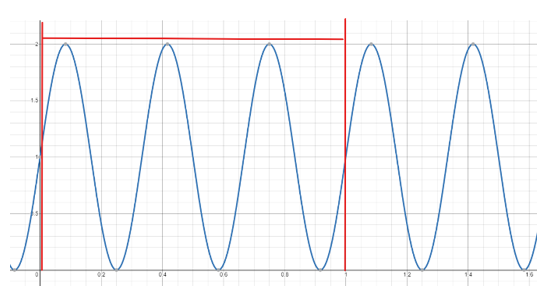
If we wrap g around the circle at a frequency f = 1, we are basically snipping a section of the graph from t = 0 to t = 1 (between the red lines) and making one complete revolution:
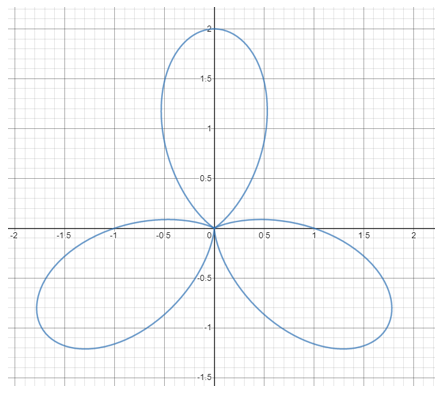
Notice how there are three peaks on g(t), from t = 0 to t = 1, correlating to three petals on our wrapped version. Now, we will wrap the function around the circle with f = 2. We are taking the same snippet as before, but forming two complete revolutions with it around the circle:
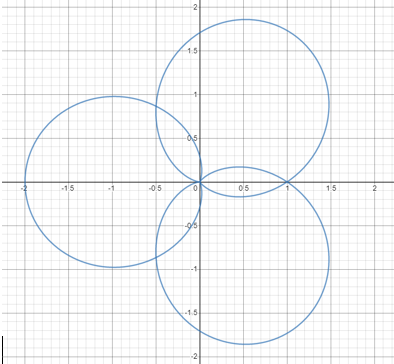
Again, we do this with f = 3, the same frequency of g. We wrap the snippet around the circle three times. As g makes three “hills” in one second, we will form three revolutions from t = 0 to t = 1. This results in each “hill” overlapping, forming one distinct shape:
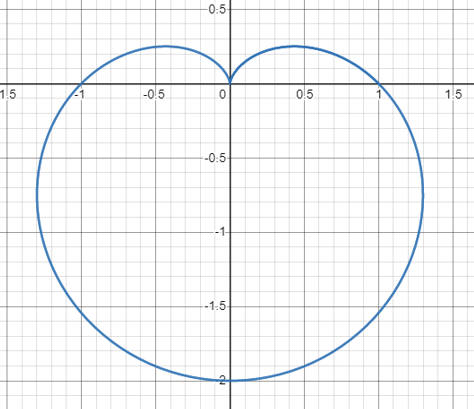
Notice how using a frequency that is highly prevalent in the function produces a unique result. One way to distinguish this result from the others is by looking at the shape’s center of mass. You will notice that the centers of mass for the first two shapes are very close to or at the origin. However, when the wrapping frequency matches that of the function, the center of mass is noticeably far from the origin. To model this mathematically, we take the center of mass of our current expression:
$ \frac{1}{t_{2}-t_{1}}\int_{t_{1}}^{t_{2}}g(t)e^{-2\pi ift}dt $
Currently, this function uses frequency f as the input variable and outputs a value that is proportional to the amount of that frequency in the function. For example, if we set f = 3, the output value will be quite high because g literally has a frequency of 3. Our current model is dividing out the length of the time interval. However, the actual Fourier transform eliminates this portion. Eliminating the division means that the longer a specific frequency is prevalent in the function, the larger the value returned. In addition, the Fourier transform usually eliminates the bounds and instead utilizes an improper integral:
$ \int_{-\infty}^{\infty}g(t)e^{-2\pi ift}dt $
Although equivalent, the common notation of the Fourier transform is denoted as transforming the function f(x) into f ̂(ξ) where ξ is the input frequency:
$ \hat{f}(\xi) = \int_{-\infty}^{\infty}f(x)e^{-2\pi i\xi x}dx $
Pictured above is the formula for the Fourier transform. Note that in this specific example I used a periodic function for g(t). Keep in mind that this transform can be applied to a non-periodic function as well. To reiterate, the Fourier transform converts from the time domain (a function g(t)) to the frequency domain (a function of ξ). In many cases, it is easier to work with and modify a function once it is broken down into its component frequencies.
4. Example
A classic example used to demonstrate the Fourier transform is with the simple rectangle function:
$ g(t)=\left\{\begin{matrix} 1 & \left | t \right |\leq 0.5\\ 0 & \left | t \right |> 0.5 \end{matrix}\right. $
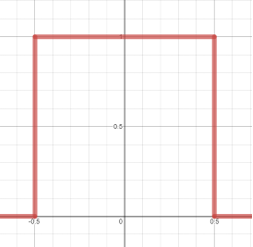
Since the function is 0 outside of -0.5 and 0.5, the value of the Fourier transform is also 0 outside the interval as well. This means we can simply integrate using bounds of -0.5 and 0.5:
$ \hat{f}(\xi) = \int_{-0.5}^{0.5}g(t)e^{-2\pi i\xi t}dt $
Now, we integrate this function, only considering the real component. Notice that we can replace g(t) with a one since its value is one on our entire bounds of integration, greatly simplifying this problem:
$ \int_{-0.5}^{0.5}g(t)e^{-2\pi i\xi t}dt = \int_{-0.5}^{0.5}1*\cos (-2\pi\xi t) dt = \frac{\sin (\pi \xi)}{\pi\xi} = sinc(\xi) $
This resultant expression is also referred to as the “sink” function, as shown above, due to its popularity and recurrence in the subject of Fourier transforms. Below is a graph of the Fourier transform of g, the sinc function:
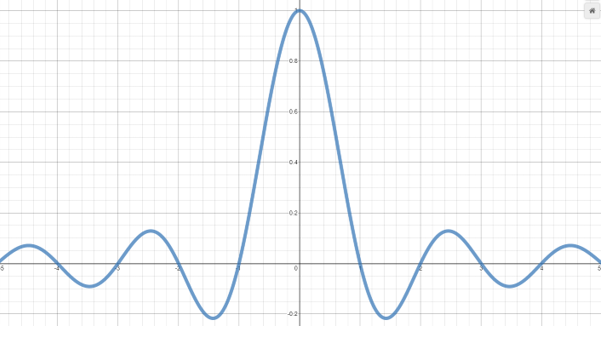
5. Inverse
Currently we have a way of transforming a function from the time domain to the frequency domain. How do we return from the frequency domain to the time domain? To do this we use the inverse transform:
$ f(x) = \int_{-\infty}^{\infty}\hat{f}(\xi)e^{2\pi i\xi x}dx $
Notice that this is simply the same equation as the Fourier transform, but without the negative in the exponent. I like to think of it as if the Fourier transform is moving clockwise due to the negative. Then, to revert to the original function, simply go counterclockwise by removing the negative.
6. Applications
Ok, so we have a way to transform a function between the time and frequency domains. Why would we ever want to do this? Sometimes a function is simpler expressed in the frequency domain. For example, when solving differential equations with boundary constraints it is sometimes quite difficult to solve in the time domain. Using the Fourier transform, one can convert to the frequency domain, solve the problem, then revert to the time domain.
Other important applications are analyzing and modifying signals. If someone wants to adjust the signal based on its frequencies, they can use the Fourier transform. If someone desires to remove an annoying frequency from a soundwave, they can simply use the transform, remove the unwanted portion, then revert back. The Fourier transform makes dealing with specific frequencies quite simple. The use of the transform for signal analysis is highly prevalent in the fields of electrical and sound engineering.
The transform is also used in the field of image processing. Many optical character recognition algorithms rely on the Fourier transform. It turns out that the Fourier transform of different characters, no matter the font, are quite distinct. In addition, the transform can detect unwanted periodic patterns in images and filter them out.
Other applications of the Fourier transform are in quantum mechanics, especially with the Uncertainty Principle.
7. References and Further Readings
In learning what the Fourier transform is, I thought that this intuitive explanation done by Blue1Brown helped a lot:
https://www.youtube.com/watch?v=spUNpyF58BY&ab_channel=3Blue1Brown (Visual Model)
Once I had an idea of what the transform is doing, these lecture notes provided a more formal analysis of the topic:
http://www.math.ncku.edu.tw/~rchen/2016%20Teaching/Chapter%202_Fourier%20Transform.pdf (Transform Lecture Notes)
And, of course, the Wikipedia article helps quite a bit:
https://en.wikipedia.org/wiki/Fourier_transform (Wikipedia Page)
If you still are having trouble understanding it, or would like to play around with a visual representation, I recommend the following two links. The first offers a depiction of how the Fourier transform can be used to write an equation out of sines. The next displays something similar but takes it to the next level with 2d drawings.
http://www.jezzamon.com/fourier/ (Normal Model)
https://betterexplained.com/articles/an-interactive-guide-to-the-fourier-transform/ (2D Drawing Model)
Additional Sources:
https://en.wikipedia.org/wiki/Euler%27s_formula (Euler's Formula Depiction)
Optical Character Recognition Document

